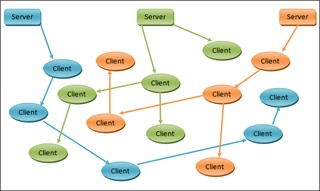Related Research Articles

Dave Winer is an American software developer, entrepreneur, and writer who resides in New York City. Winer is noted for his contributions to outliners, scripting, content management, and web services, as well as blogging and podcasting. He is the founder of the software companies Living Videotext, Userland Software and Small Picture Inc., a former contributing editor for the Web magazine HotWired, the author of the Scripting News weblog, a former research fellow at Harvard Law School, and current visiting scholar at New York University's Arthur L. Carter Journalism Institute.
RSS is a web feed that allows users and applications to access updates to websites in a standardized, computer-readable format. Subscribing to RSS feeds can allow a user to keep track of many different websites in a single news aggregator, which constantly monitor sites for new content, removing the need for the user to manually check them. News aggregators can be built into a browser, installed on a desktop computer, or installed on a mobile device.
BitTorrent, also referred to as simply torrent, is a communication protocol for peer-to-peer file sharing (P2P), which enables users to distribute data and electronic files over the Internet in a decentralized manner. The protocol is developed and maintained by Rainberry, Inc., and was first released in 2001.
Web syndication is making content available from one website to other sites. Most commonly, websites are made available to provide either summaries or full renditions of a website's recently added content. The term may also describe other kinds of content licensing for reuse.
On the World Wide Web, a web feed is a data format used for providing users with frequently updated content. Content distributors syndicate a web feed, thereby allowing users to subscribe a channel to it by adding the feed resource address to a news aggregator client. Users typically subscribe to a feed by manually entering the URL of a feed or clicking a link in a web browser or by dragging the link from the web browser to the aggregator, thus "RSS and Atom files provide news updates from a website in a simple form for your computer."
In software architecture, publish–subscribe is a messaging pattern where publishers categorize messages into classes that are received by subscribers. This is contrasted to the typical messaging pattern model where publishers send messages directly to subscribers.
KTorrent is a BitTorrent client that is part of the KDE Gear.

In computing, a news aggregator, also termed a feed aggregator, content aggregator, feed reader, news reader, or simply an aggregator, is client software or a web application that aggregates digital content such as online newspapers, blogs, podcasts, and video blogs (vlogs) in one location for easy viewing. The updates distributed may include journal tables of contents, podcasts, videos, and news items.

P2PTV refers to peer-to-peer (P2P) software applications designed to redistribute video streams in real time on a P2P network; the distributed video streams are typically TV channels from all over the world but may also come from other sources. The draw to these applications is significant because they have the potential to make any TV channel globally available by any individual feeding the stream into the network where each peer joining to watch the video is a relay to other peer viewers, allowing a scalable distribution among a large audience with no incremental cost for the source.
The UDP tracker protocol is a high-performance low-overhead BitTorrent tracker protocol. It uses the stateless User Datagram Protocol (UDP) for data transmission instead of the HTTP protocol regular trackers use. The data is in a custom binary format instead of the standard bencode algorithm BitTorrent uses for most communication.
Protocol encryption (PE), message stream encryption (MSE) or protocol header encrypt (PHE) are related features of some peer-to-peer file-sharing clients, including BitTorrent clients. They attempt to enhance privacy and confidentiality. In addition, they attempt to make traffic harder to identify by third parties including internet service providers (ISPs). However, encryption will not protect one from DMCA notices from sharing not legal content, as one is still uploading material and the monitoring firms can merely connect to the swarm.
Peer exchange or PEX is a communications protocol that augments the BitTorrent file sharing protocol. It allows a group of users that are collaborating to share a given file to do so more swiftly and efficiently.
Miro was an audio, video player and Internet television application developed by the Participatory Culture Foundation. It runs on Microsoft Windows, macOS, FreeBSD and Linux and supports most known video file formats. It offers both audio and video, some in HD quality.

Tribler is an open source decentralized BitTorrent client which allows anonymous peer-to-peer by default. Tribler is based on the BitTorrent protocol and uses an overlay network for content searching. Due to this overlay network, Tribler does not require an external website or indexing service to discover content. The user interface of Tribler is very basic and focused on ease of use instead of diversity of features. Tribler is available for Linux, Windows, and OS X.
The following is a general comparison of BitTorrent clients, which are computer programs designed for peer-to-peer file sharing using the BitTorrent protocol.
Windows RSS Platform, included in Internet Explorer 7 and later and Windows Vista and later is a platform that exposes feed handling and management to Windows applications. The RSS support in Internet Explorer is built on the Windows RSS Platform.
Social network aggregation is the process of collecting content from multiple social network services into a unified presentation. Examples of social network aggregators include Hootsuite or FriendFeed, which may pull together information into a single location or help a user consolidate multiple social networking profiles into a single profile.
Micro Transport Protocol is an open User Datagram Protocol-based (UDP-based) variant of the BitTorrent peer-to-peer file sharing protocol intended to mitigate poor latency and other congestion control problems found in conventional BitTorrent over Transmission Control Protocol (TCP), while providing reliable, ordered delivery.
Mainline DHT is the name given to the Kademlia-based distributed hash table (DHT) used by BitTorrent clients to find peers via the BitTorrent protocol. The idea of using a DHT for distributed tracking in BitTorrent was first implemented in Azureus 2.3.0.0 in May 2005, from which it gained significant popularity. Unrelated but around the same time, BitTorrent, Inc. released a similar DHT into their client called Mainline DHT, and thus popularized the use of distributed tracking in the BitTorrent protocol. Measurement showed that by 2013, the concurrent number of users of Mainline DHT is from 16 million to 28 million, with intra-day changes of at least 10 million.

μTorrent, or uTorrent, is a proprietary adware BitTorrent client owned and developed by Rainberry, Inc. The "μ" in its name comes from the SI prefix "micro-", referring to the program's small memory footprint: the program was designed to use minimal computer resources while offering functionality comparable to larger BitTorrent clients such as Vuze or BitComet. μTorrent became controversial in 2015 when many users unknowingly accepted a default option during installation which also installed a cryptocurrency miner.
References
- ↑ Broadcatch Definition company website, (2001 archive)
- ↑ - The Media Lab Review. L. McGuff. Beyond Cyberpunk, Gareth Branwyn, ed., 1991. Retrieved 2007-04-22
- ↑ Gillmor, Steve. BitTorrent and RSS Create Disruptive Revolution EWeek.com, December 13, 2003. Retrieved on 2016-02-21.
- ↑ Raymond, Scott: Broadcatching with BitTorrent Archived 2012-07-09 at the Wayback Machine . scottraymond.net: 2003-12-16.
- ↑ Zengbin Zhang; Yuan Lin; Yang Chen; Yongqiang Xiong; Jacky Shen; Hongqiang Liu; Beixing Deng; Xing Li (2009). "Experimental Study of Broadcatching in BitTorrent" (PDF). Proc. of 6th IEEE Consumer Communications and Networking Conference (CCNC'09). Archived from the original (PDF) on 2013-02-17. Retrieved 2012-05-13.
- ↑ "KTorrent's syndication plugin". Archived from the original on 2011-05-21. Retrieved 2011-04-29.
- ↑ Tixati.com - Home